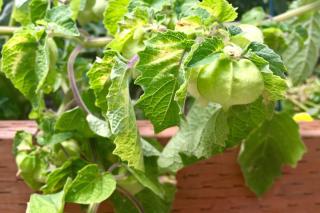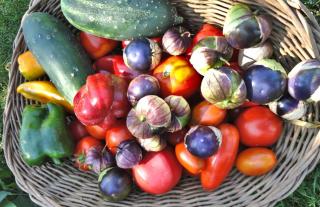

A rarer form of Physalis, tomatillo is a late summer vegetable that is easy to grow since the plant resists disease well. Tomatillo fruits are usually cooked and help soften the spice in many Central American recipes.
Botanical name – Physalis ixocarpa, Physalis philadelphica
Common name – Tomatillo
Family – Solanaceae (nightshade family)
Type – annual
Height – 2 feet to 3 feet (0.6 m to 1 m)
Planting distance – 32 to 36 inches (80 to 100 cm)
Exposure – full sun
Soil – light, full of humus and well draining
Planting – March, April Harvest – August to October
Tomatillo is a type of physalis that is much less common than its cousin Peruvian groundcherry. Native to Central America, fruits at first resemble normal tomatoes, but as they mature the color changes to becomes either yellow or purple depending on the variety. If you wish to add something truly original to your vegetable patch and to your meals, this annual is the perfect one for you!
If your soil is very clayish (typical of heavy soil types), you’ll have to lighten it before planting tomatillo. In Fall, take the time to amend the soil. This entails nothing more than simply adding sand and soil mix to the soil. If you’ve got a chimney or wood stove, keep some of the spent ashes and spread them in the vegetable patch.
The next step you’ll have to perform whatever your soil type: till and turn the soil over to a depth of about a foot with a spading fork.
A spading fork is better than a normal spade since it doesn’t slice our worm friends in half.
In Spring, just before planting your tomatillo seedlings, turn the soil over one last time, but shallow work will do, only a few inches.
 As is done for many plants in the vegetable patch, you’ll probably start with sowing. Get this first step done in March-April:
As is done for many plants in the vegetable patch, you’ll probably start with sowing. Get this first step done in March-April:
Tomatillo is a typical summer vegetable, inasmuch as the soil needs to warm up before it can spread and grow well. Simply match the sowing and transplanting calendar with that of regular tomato.
The Physalis family numbers over 100 different species, but it’s often difficult to come across seeds for many of them.
Some varieties of tomatillo that are easier to find include:
There’s no need to prune or trim tomatillo. As for care, nothing more to do than just water each seedling regularly, without drowning them though (especially if the soil tends to retain water well).
Organic farming is clearly becoming a thing these days, and avoiding chemical pesticides is all the rage. A precious advantage of tomatillo is that it’s not vulnerable to diseases and pests at all…
 Depending on the planting date, expect first fruits to appear around July.
Depending on the planting date, expect first fruits to appear around July.
Once they’re picked, ripe fruits will keep for 1 to 2 weeks if provided with proper, dry storage.
Tomatillo fruits are eaten cooked, because when raw they’re not particularly palatable. Don’t expect a tomato-like taste! The taste is both bland and slightly off, and some species leaves an uncomfortable coating in the mouth when raw.
Cooked, though, it’s something else alltogether. They’re perfect for many Mexican recipes such as salsa verde. Additionally, when mashed, tomatillo paste also softens spicy preparations.
Just as you’d do for regular tomato plants, remember to stake your tomatillo plants, otherwise branches would break off if fruits are too abundant.